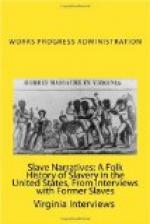“The children are raised now without manners. When I have to go past Capitol Hill School, I have to get off the sidewalk. Ain’t nothin’ but these graduates teachin’ now, young graduates that don’t know nothin’ but runnin’ about. When I come along, the carpetbaggers were teaching and they knew their business. Mrs. Stephens went to Fisk and finished there. Mrs. Spight graduated from Union High School. We had all white teachers at first. Miss Sarah Henley used to teach with old ex-slaves where the Bethel A.M.E. Church is now. There wasn’t no church there then—just a little shanty. I was just five years old. My mother used to take me there and leave me, but she taught me herself at home. She taught me just like I see you teach your kids.
“Boys don’t do nothing but play now. They had to hustle then. They can’t do nothing now. They have this departmental system now. They didn’t have it then. The different temperaments ruin children. They used to review, now they don’t. They change text-books so fast the old ones can’t be sold.”
Interviewer’s Comment
Warren Taylor holds recommendations from a number of prominent people referring to his excellent character, high morals, unusual intelligence, wide information, industry, thrift, honesty, and trustworthiness. Some of the names occur in the interview. The letters and documents proving his long service and good record were brought out during the interview and given to me to read.
He has an unusual memory and penetrating insight into conditions.
Interviewer: Miss Irene Robertson
Person interviewed: Sneed Teague
Brinkley,
Arkansas
Age: 68
Occupation: Works on railroad
“My owners was Miss Betsy and Master Teague. Miss Betsy had a sister lived with them. Her name was Miss Polly. They was French folks from the old country.
“My ma had belong to the Cox before the Teagues owned her. The Teagues had three families of servants.
“I remember them—yes mam—they was very saving people. They made everything that they used. The shettle, the carding machine, the spinning wheel and all, they made em. They had a carding machine different to anybodys in the country. It worked by a foot treadle. Another thing wasn’t like nobody elses in the whole country was the bed. It had four tall post. The head board a little higher than the one at the foot but instead of using slats across from the railings it was mortised together and hemp ropes wove bout a inch apart. It was strong and didn’t seem to give (stretch) much.




